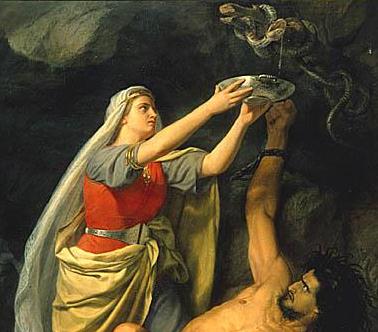
Basics of Loki:
In Norse mythology, Loki or Loptr is a god or jötunn (or both). Loki is the son of Fárbauti and Laufey, and the brother of Helblindi and Býleistr.
By the jötunnAngrboða, Loki is the father of Hel, the wolf Fenrir, and the world serpent Jörmungandr. By his wife Sigyn, Loki is the father of Nari
or Narfi. And with the stallion Svaðilfari as the father, Loki gave birth in the form of a mare to the eight-legged horse Sleipnir. In addition, Loki is referred
to as the father of Váli in the Prose Edda.
Loki's relation with the gods varies by source. Loki sometimes assists the gods and sometimes causes problems for them.
Loki is a shape shifter and in separate incidents he appears in the form of a salmon, mare, seal, a fly, and possibly an elderly woman.
Loki's positive relations with the gods end with his role in engineering the death of the god Baldr.
Loki is eventually bound by the gods with the entrails of one of his sons.
In both the Poetic Edda and the Prose Edda, the goddess Skaði is responsible for placing a serpent above him while he is bound.
The serpent drips venom from above him that Sigyn collects into a bowl; however, she must empty the bowl when it is full, and the venom that drips
in the meantime causes Loki to writhe in pain, thereby causing earthquakes. With the onset of Ragnarök, Loki is foretold to slip free from his
bonds and to fight against the gods among the forces of the jötnar, at which time he will encounter the god Heimdallr and the two will slay each other.
Loki is attested in the Poetic Edda, compiled in the 13th century from earlier traditional sources; the Prose Edda and Heimskringla,
written in the 13th century by Snorri Sturluson; the Norwegian Rune Poem, in the poetry of skalds, and in Scandinavian folklore.
Loki may be depicted on the Snaptun Stone, the Kirkby Stephen Stone, and the Gosforth Cross. Loki's origins and role in Norse mythology,
which some scholars have described as that of a trickster god, have been much debated by scholars.
More about Loki: Loki is one of the major deities in the Norse pantheon. He is a son of the giant Farbauti ("cruel striker") and the giantess Laufey. He is regarded as one of Aesir, but is on occasion their enemy. He is connected with fire and magic, and can assume many different shapes (horse, falcon, fly). He is crafty and malicious, but is also heroic: in that aspect he can be compared with the trickster from North American myths. The ambivalent god grows progressively more unpleasent, and is directly responsible for the death of Balder, the god of light. Loki's mistress is the giantess Angrboda, and with her he is the father of three monsters. His wife is Sigyn, who stayed loyal to him, even when the gods punished him for the death of Balder. He was chained to three large boulders; one under his shoulders, one under his loins and one under his knees. A poisonous snake was placed above his head. The dripping venom that lands on him is caught by Sigyn in a bowl. But every now and then, when the bowl is filled to the brim, she has to leave him to empty it. Then the poison that falls on Loki's face makes him twist in pain, causing earthquakes. On the day of Ragnarok, Loki's chains will break and he will lead the giants into battle against the gods. Loki is often called the Sly One, the Trickster, the Shape Changer, and the Sky Traveler.
Asgards gods and goddesses, Brought to you by Daniel Lorenz.